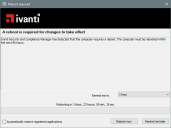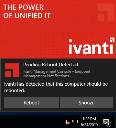Agent settings: Reboot settings
Tools > Configuration > Agent Settings > Reboot settings
Administrators now have better control over the reboot experience. With the Reboot settings, administrators can create reboot policies that are consistent across scheduled tasks. These settings will override the default agent settings on the client.
NOTE: Reboot settings do not apply to the reboot task that you start from the device list. If you right-click a machine in the device list and click Reboot, that task immediately attempts to reboot the device, overriding all reboot settings and global settings in the Agent configuration dialog box.
About the General page
Use the General page to specify when to initiate the reboot process. Once you select options on the other pages of the dialog box, the General page displays a summary of the settings.
The General page contains the following options:
- Name: Enter a unique identifier for the reboot settings that you specify on all of the pages of the dialog.
- When deciding whether a reboot is needed
- Act as if reboot is ALWAYS needed: Forces a reboot even if neither the Windows OS nor the Ivanti agent indicate the need for one. For example, if there is a virus or malware, you may want to install a patch and force a reboot for security reasons.
- Detect whether reboot is needed: Checks with both the Windows OS and the Ivanti agent and initiates a reboot if either one recommends it. For example, once you install agents on devices, they may need a reboot to complete the agent configuration.
- Act as if reboot is NEVER needed: Disables all other reboot settings so that Ivanti tasks will not reboot the machine, even if the Windows OS or Ivanti agent recommends a reboot.
- Suppress Windows Update reboot notifications: Prevents the Windows Update service from displaying reboot notifications in the task tray. The end user will not see any reboot messages from Windows Update.
About the Prompt page
Use the Prompt page to customize the reboot dialog that will display on the end user's device. You can also configure branding options if you want to customize the prompt's appearance.
Default legacy notification dialog box:
Default Action Center notification (2020.1 SU1 and newer):
NOTE: The prompt will only appear if the user is logged in and the machine is not locked. Otherwise, the machine may reboot without displaying the prompt.
The Prompt page contains the following options:
- Prompt user before rebooting: Click to enter a custom message the user will see in a reboot prompt before the reboot occurs. In addition to the options below, users will have the chance to select an Automatically restart registered applications option (disabled by default). When this option is enabled, applications that have registered with the Windows restart manager will relaunch and resume their current state after the reboot, which helps make a reboot less inconvenient.
- Use default message: Click to discard a custom message you entered and restore the default message.
Allow users to defer (snooze) for: Adds a Snooze button to the notification. The behavior of this button depends on whether the user sees the legacy notification or the Windows Action Center notification.
Legacy notification: Clicking the Snooze button allows the user to choose how many times to defer and how long to wait within this time period.
Action Center notification: Clicking the Snooze button closes the notification for the interval you specified. Once that interval passes, the notification reappears. For example, if you set this to 10 minutes, the notification reappears 10 minutes after the Snooze button is clicked. If the user doesn't click the Snooze button within that interval, the reboot happens automatically at the end of the interval.
If automatic reboots aren't enabled on the Automatic reboot page, then the user will be prompted indefinitely according to the time set here and both the Reboot and Snooze buttons will be enabled.
- Show system tray icon when a reboot is required: Displays the icon in the system tray, which allows the user to access the reboot prompt. For example, if a user chooses to defer the reboot for four hours but then has time to do it an hour later, the icon in the system tray allows them to reboot sooner than they previously specified.
- Customize window caption: Click to enter the text that will appear in the title bar of the reboot prompt.
For more information on configuring notifications, see Customizing notification messages on managed devices.
About the Automatic reboot page
Use the Automatic reboot page to specify the circumstances for a forced reboot.
The Automatic reboot page contains the following options:
- Automatically reboot if any of these options are selected: The reboot will occur if the machine meets any of the selected options, whichever happens first.
- Logged out for: The machine will reboot if the user has been logged out for the specified amount of time.
- Locked or logged out for: The machine will reboot if the machine has been locked or logged out for the specified amount of time. Use this option if you want to reboot while the machine is locked, such as during a lunch break or while the user is away in a meeting.
- No response to reboot prompt for: The machine will reboot if the user does not defer or reboot for the specified amount of time.
Reboot deadline exceeds: The machine will reboot if the user does not reboot before that time. For example, if you have an important security update that must occur in the next three days, set the deadline to 3 days. The reboot deadline must be equal to or greater than the Allow users to defer for time on the Prompt page.
Prior to the deadline you set, users can click a Snooze button on the reboot notification. Text above the snooze button tells them how long they can snooze for. After the deadline, the Snooze button is removed and the notification text indicates that a mandatory reboot will occur automatically at a specific time.
- Limit automatic reboot in the specified time window: The machine will only reboot if it is in that window, even if the reboot deadline has occurred. Specify the maintenance window by setting a weekly schedule. For example you could set it to reboot on the weekend if you had a point-of-sale machine that cannot reboot during business hours.
About the Do not disturb page
Use the Do not disturb page to override the settings on the other pages of the Reboot dialog.
The Do not disturb page contains the following options:
- Do not reboot or prompt to reboot if specified processes are running: Specify mission-critical processes so that a reboot will not occur if those processes are running.
- Add...: Opens the Specify process filter dialog box, where you can enter the name of the process and specify whether to apply the filter any time the process is running or only when the process is running full screen. For example, to ensure that a machine does not reboot during a presentation, you could apply the filter so that a reboot could occur with PowerPoint open but not if PowerPoint was running full screen.
- Edit...: Opens the Specify process filter dialog box, where you can change the filter for a process that is already in the list.
- Delete...: Removes a process from the list.
- Import...: Opens the Import dialog box, where you can select processes from the Do not disturb lists in other settings, such as Distribution and patch.

